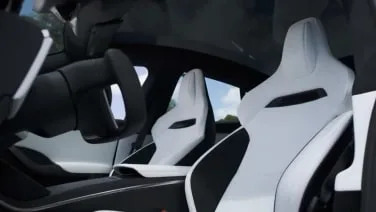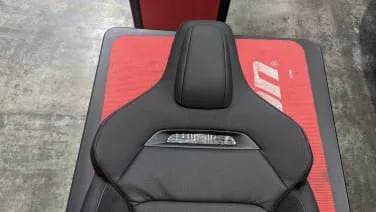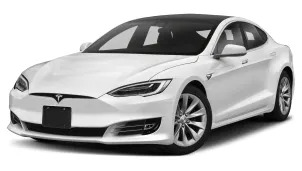2017 Tesla Model S
The combination of a sexy shape and sensational speed is quite electric. That would be the Tesla S. Oh, there's that too, the all-electric power. The Model S is now in the sixth year of its first generation, new in 2012.
The S comes in four choices of battery capacity: 60, 75, 90, or 100 kilowatt hours. The small 60 kwh is rear-wheel drive, the others all-wheel drive.
The rear-drive S uses a 270-kilowatt (362 horsepower) motor. The awd D models use two 193-kw (259 hp) motors, mounted front and rear, one for each axle. The ultimate P100D model puts even more power to the rear, 375 kilowatts (503 hp).
The silent acceleration is astonishing, as quick of some of the fastest supercars in the world.
The BMW i3 notwithstanding, the closest competitor or comparison to the Tesla S might be the Audi A7, with its similar fastback shape and four doors. Or maybe the Jaguar F Type, or even the luscious Maserati Ghibli. But neither BMW nor Mercedes have a car as sleek as the Tesla S.
The cabin is disappointing. Electric engineering aside, two out of three isn't good enough. Got performance, got styling, but the interior is stark, dominated by a giant 17-inch touchscreen in the center of the dash.
The standard suspension is firm, but the optional air suspension provides choices, from super soft to super firm.
The Tesla S handles way better than a sedan that's this heavy should. The curb weight of nearly 5000 pounds would be more, if not for the aluminum structure, same as the Audi A8, Jaguar XJ, and Range Rover. The cornering is remarkably flat, thanks to the low center of gravity and ideal weight distribution enabled by the battery pack. It's mounted under the floor, protected from road debris by a titanium/aluminum shield.
The EPA says the rear-wheel-drive S can go 218 miles on a charge, and the awd models increase the range up to 315, depending on battery size. That works out to 89 to 104 MPGe combined. (MPGe, or Miles Per Gallon Equivalent, is the distance an electric car can travel on the energy contained in one gallon of gasoline.) That's at average speeds, not sustained freeway or with heavy use of the climate controls, which cut 10 to 25 percent off the range.
There are controversies around its crashworthiness. The NHTSA gives the Tesla S top scores in every category (however the all-wheel-drive models haven't been fully crash-tested). But the IIHS basically sent Tesla back to the drawing board in the small-overlap test that's like hitting a tree, and added insult to injury by rating the headlamps Poor. The company says its working on a fix to the chassis of the Tesla S, so it can survive impact with a tree better but hasn't said when that fix will be in the cars.
There are more controversies around its drivability. After failures of the self-driving Autopilot mode, it was improved in 2016, but not proven bomb-proof …
Full Review
Full Review
The Model S is now in the sixth year of its first generation, new in 2012.
The S comes in four choices of battery capacity: 60, 75, 90, or 100 kilowatt hours. The small 60 kwh is rear-wheel drive, the others all-wheel drive.
The rear-drive S uses a 270-kilowatt (362 horsepower) motor. The awd D models use two 193-kw (259 hp) motors, mounted front and rear, one for each axle. The ultimate P100D model puts even more power to the rear, 375 kilowatts (503 hp).
The silent acceleration is astonishing, as quick of some of the fastest supercars in the world.
The BMW i3 notwithstanding, the closest competitor or comparison to the Tesla S might be the Audi A7, with its similar fastback shape and four doors. Or maybe the Jaguar F Type, or even the luscious Maserati Ghibli. But neither BMW nor Mercedes have a car as sleek as the Tesla S.
The cabin is disappointing. Electric engineering aside, two out of three isn't good enough. Got performance, got styling, but the interior is stark, dominated by a giant 17-inch touchscreen in the center of the dash.
The standard suspension is firm, but the optional air suspension provides choices, from super soft to super firm.
The Tesla S handles way better than a sedan that's this heavy should. The curb weight of nearly 5000 pounds would be more, if not for the aluminum structure, same as the Audi A8, Jaguar XJ, and Range Rover. The cornering is remarkably flat, thanks to the low center of gravity and ideal weight distribution enabled by the battery pack. It's mounted under the floor, protected from road debris by a titanium/aluminum shield.
The EPA says the rear-wheel-drive S can go 218 miles on a charge, and the awd models increase the range up to 315, depending on battery size. That works out to 89 to 104 MPGe combined. (MPGe, or Miles Per Gallon Equivalent, is the distance an electric car can travel on the energy contained in one gallon of gasoline.) That's at average speeds, not sustained freeway or with heavy use of the climate controls, which cut 10 to 25 percent off the range.
There are controversies around its crashworthiness. The NHTSA gives the Tesla S top scores in every category (however the all-wheel-drive models haven't been fully crash-tested). But the IIHS basically sent Tesla back to the drawing board in the small-overlap test that's like hitting a tree, and added insult to injury by rating the headlamps Poor. The company says its working on a fix to the chassis of the Tesla S, so it can survive impact with a tree better but hasn't said when that fix will be in the cars.
There are more controversies around its drivability. After failures of the self-driving Autopilot mode, it was improved in 2016, but not proven bomb-proof …
Hide Full Review
Retail Price
| Engine | |
| MPG | Up to 102 city / 107 highway |
| Seating | 5 Passengers |
| Transmission | 1-spd auto |
| Power | 382 - 762 hp |
| Drivetrain | all wheel, rear-wheel |
| Curb Weight | 4,469 - 4,941 lbs |





